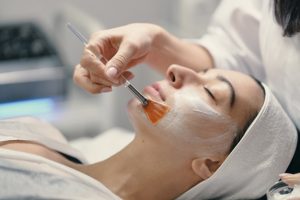
- The peeling may take anywhere from 5-10 days on average or longer depending on internal and external factors such as skin type, age, weather, lifestyle, and hormones.
- Slight redness and skin sensitivity and flaking can occur as your treatment eliminates dead surface skin cells. Each treatment may vary. Other areas of the body will react differently because your skin has a different texture on your face and scalp than on your chest, back, arms, and legs. The healing process may take longer in those areas.
- Your skin may take on a rough, patchy, darkened quality a few days after this treatment. This is normal and expected and it will resolve on its own. The first areas to peel are usually around the nose and mouth, but can begin anywhere. Most people begin peeling on the 3rd or 4th day after treatment. It is also possible to not peel at all. If this occurs, you will still benefit from the treatment because the skin has exfoliated microscopically.
- Possible side effects include but are not limited to: mild to extreme redness, temporary tightness, itching, swelling, and dryness of the skin similar to a sunburn or windburn. This will usually subside in 2-3 days. A prescription of mild to moderate steroid cream may be recommended if the skin is inflamed or irritated.
- You may GENTLY apply a cold compress to the treated area(s) as needed for any burning or irritation associated with your treatment.
- Make sure to avoid excessive heat on the treated area and direct sun exposure of any kind, as well as tanning beds and self-tanners to the treated areas for 4 weeks after treatment.
- Do not engage in strenuous exercise for 2-3 days after treatment because it may exacerbate the inflammatory and can cause your skin to become extremely inflamed.
- Sweating excessively after treatment can irritate the skin or cause blistering due to the sweat being unable to escape through the top layer of dead skin. Try to avoid sweating until after you have stopped peeling to avoid lifting the skin prematurely, as this can cause scarring.
- Do not use any acidic products such as retinoids or tretinoins, acne medication products such as Retin-A, Tazorac, Renova, Atralin, Ziana, Veltin, Differin, the antibiotic Doxycycline, AHAs (lactic, glycolic, tartaric, etc.), BHAs (salicylic), benzoyl peroxide, vitamin C products, lightening agents such as hydroquinone or any exfoliative products including loofahs or coarse sponges to your skin for 2 weeks after your chemical peel, or more if you notice your skin becomes sensitive to application. These medications and products increase your photosensitivity, which can significantly increase the likelihood of complications.
- Do NOT tweeze, pick, rub, exfoliate, wax, use a depilatory, undergo electrolysis, or schedule a facial or cosmetic service such as laser resurfacing, or IPL on a treated area(s) for 4 weeks after your treatment. To reduce the risk of scarring, you do not want to remove the dry, rough, dead skin faster than your body wants to.
- Do NOT get your hair dyed until a week after you have finished peeling, if your treatment was performed on the face or neck. For most people, week 3 post-peel is the best time to have your hair color treated.
- This procedure can stimulate cold sores. If you have an outbreak after your treatment, please call the office to inquire about obtaining a prescription.
Proper post-peel skin care
Wash your face with cool water. Warm or hot water might not feel as good as cool or cold water, which can help soothe post-peel sensations.
Moisturize and hydrate. Since peels can temporarily compromise your skin’s protective barrier, it’s important to reinforce that barrier with a medium-to-thick moisturizer. Also, drink more water to help avoid dehydration, which could make your skin feel tight.
Apply sunscreen with SPF50 or more. Your skin is more delicate after a peel, so avoid direct sun exposure, which can lead to even more visible signs of skin aging. If you must be exposed, use a Broad Spectrum physical sunscreen.
Avoid strenuous workouts, dry saunas and steam rooms. Increased blood circulation to the face can intensify warming, tingling, itching, redness or other uncomfortable side effects on freshly peeled skin. Skip such activities on the day you use a peel.
Don’t over-exfoliate. Peels are maximum-strength exfoliants, so you don’t need to use a separate exfoliant (like a scrub, brush or exfoliating cleanser) within 3-4 days of your peel. Over-exfoliating can lead to more redness or sensitivity, so wait until your skin feels up to it.
We provide various chemical peels for acne, skin brightening, exfoliation and facial rejuvenation in Bangalore.
Dr. Shilpa Y. K.
Consultant & Founder,
Derma Elite Skin Care Clinic
